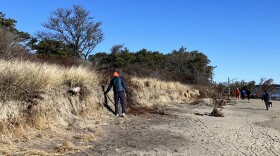Buried deep in the Mississippi Valley is an Indigenous medieval city known as Cahokia.
Today, the ancient civilization’s massive remains are a modern-day historical park located in Collinsville, Illinois. But in medieval times, the city was the largest in North America — making it a UNESCO World Heritage Site and a state historic site.
While excavation of some of the historic “mounds” at the site have been studied, there are outer areas or “suburbs” that are attracting scholarly interest.
Sarah Baires, an associate professor of anthropology at Eastern Connecticut State University, has won a National Science Foundation (NSF) grant to study Cahokia, and her students will get the chance to study the ancient site alongside her.
Baires will investigate the early occupation of the city, examining how neighborhoods on its outskirts relate to the central “downtown” area, in terms of culture and infrastructure. Baires believes this historical site holds lessons about why people began to congregate in cities.
“We need a broader understanding of the people who are coming to the city and living on its edges,” Baires said. “How they are incorporating themselves into this urban environment. Are they bringing with them their community traditions from where they came from? Are they changing them when they get here? How are they participating in this city of Cahokia?”
As many as 20,000 people lived in Cahokia, which is located on the Illinois side of the Mississippi River, near present-day St. Louis, Missouri. The city existed from about 1000 to 1400, a time when London and Paris were also developing.
The reason for its abandonment is not known. Melissa Baltus, an associate professor of anthropology at the University of Toledo, will be a co-principal investigator with Baires on the project, and Baltus will study the late collapse of the city.
Large burial mounds, which have been extensively excavated, remain at the site. But Baires and her team will focus more on two locations on the outskirts of the city. They plan to use non-invasive techniques such as magnetometry to conduct their research. The technology allows for the high-speed sampling of what lies beneath the ground without actually digging in the soil.
Eastern Connecticut State University students will have the opportunity to participate in the study through archaeological field schools starting in the summer of 2024. Students will also have the chance during the academic year to analyze artifacts brought back from the field to Baires’ lab at the university.
Baires and her team will look for evidence of how involved people in peripheral neighborhoods were in the ideologies and practices of the central city of Cahokia. She said she is interested in questions such as: What were the motivating factors behind why human beings began to congregate in cities, and what did they gain?
Baires and her colleagues hope this information can be applicable to contemporary experiences, particularly in the context of human migration and movement beyond cities and into new ones.
The NSF award is for five years with a total funding allocation of $128,000.





